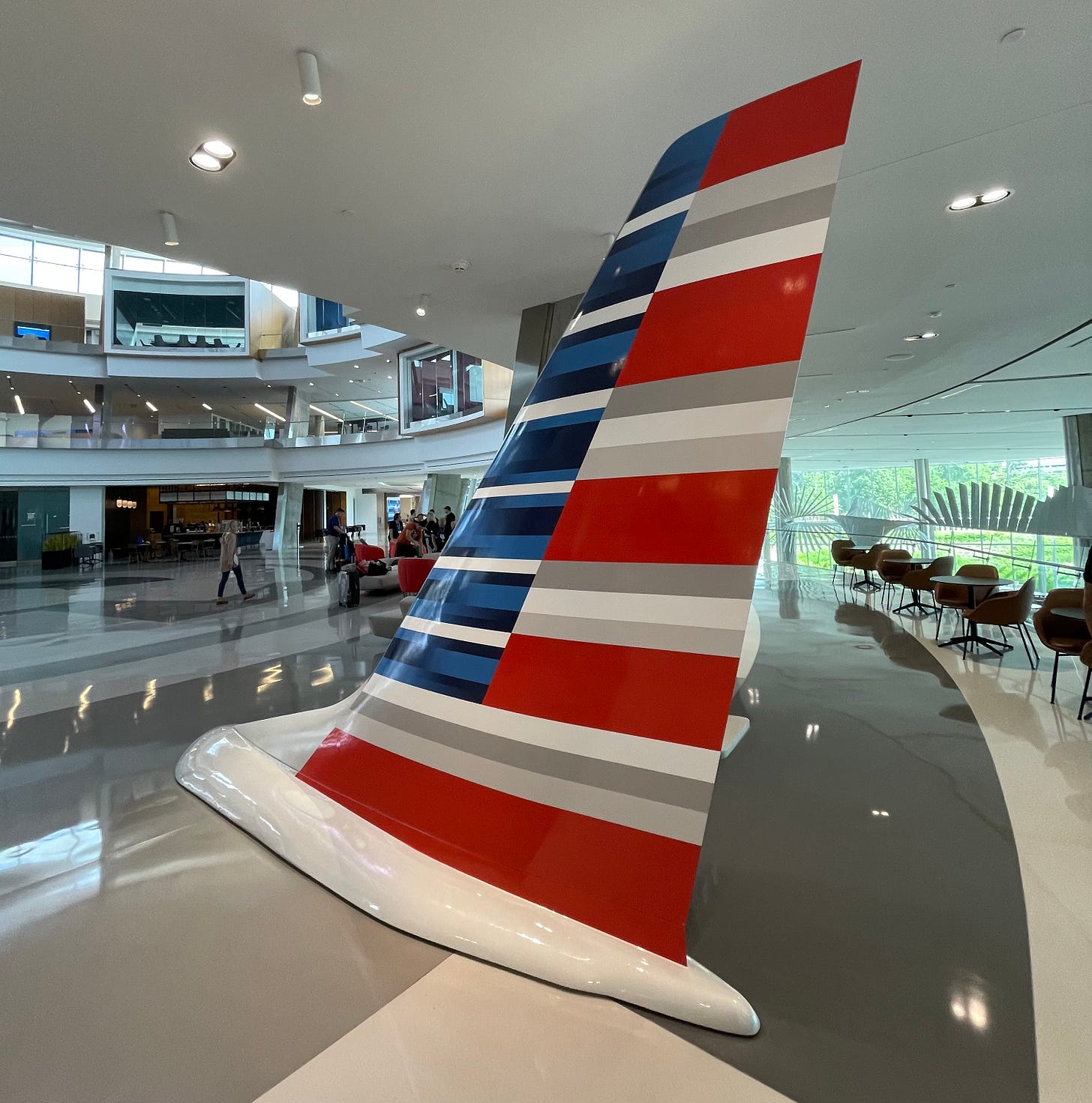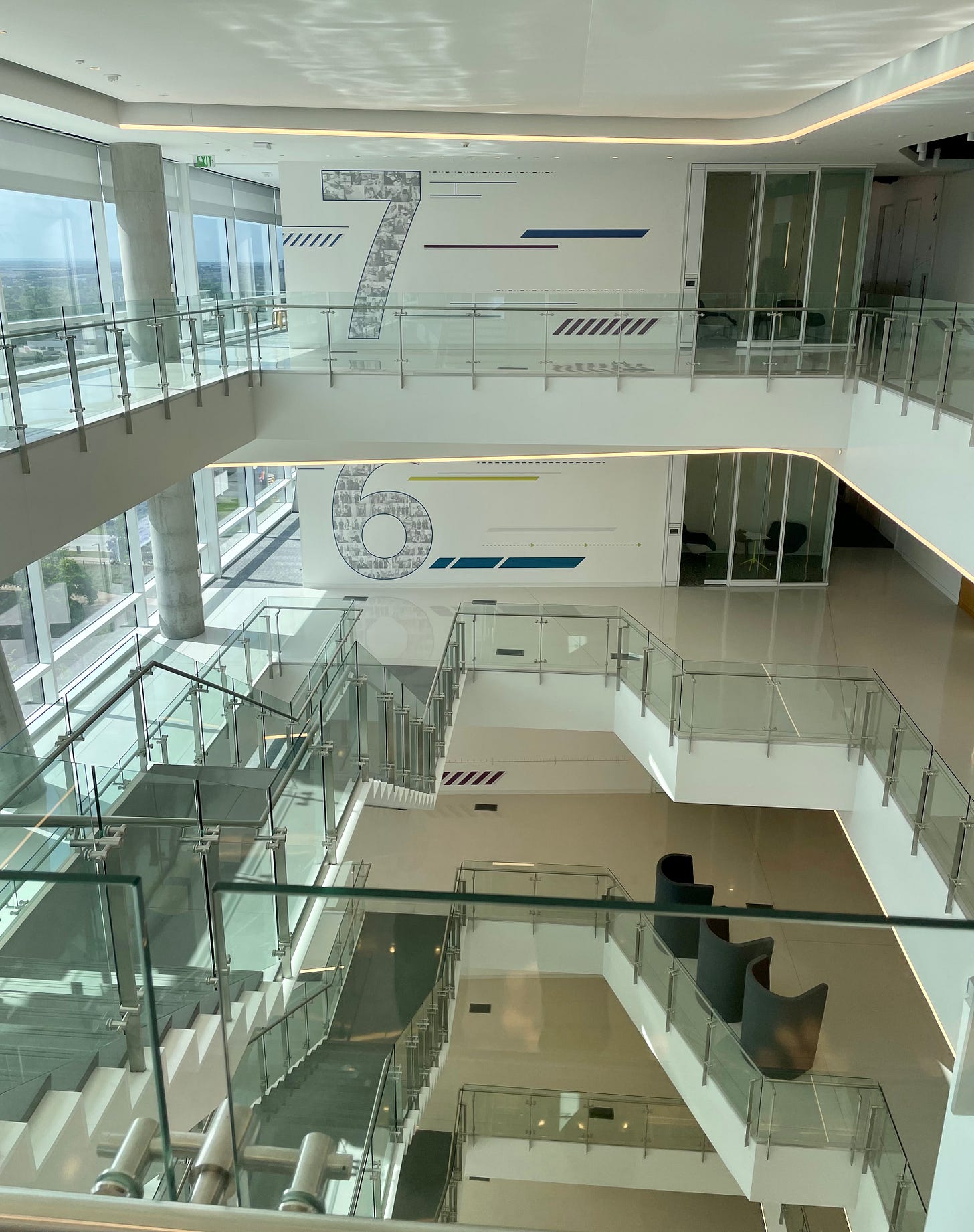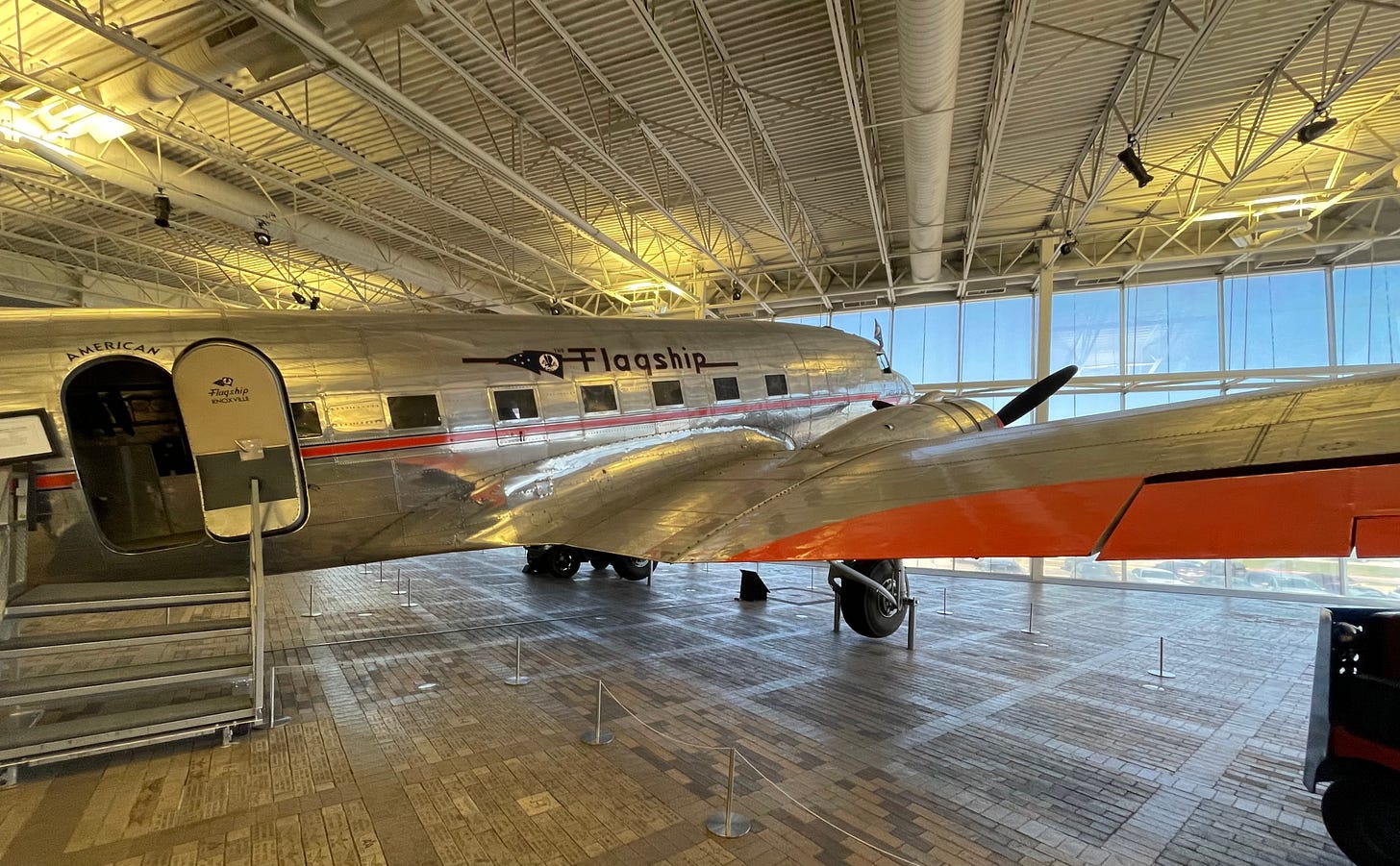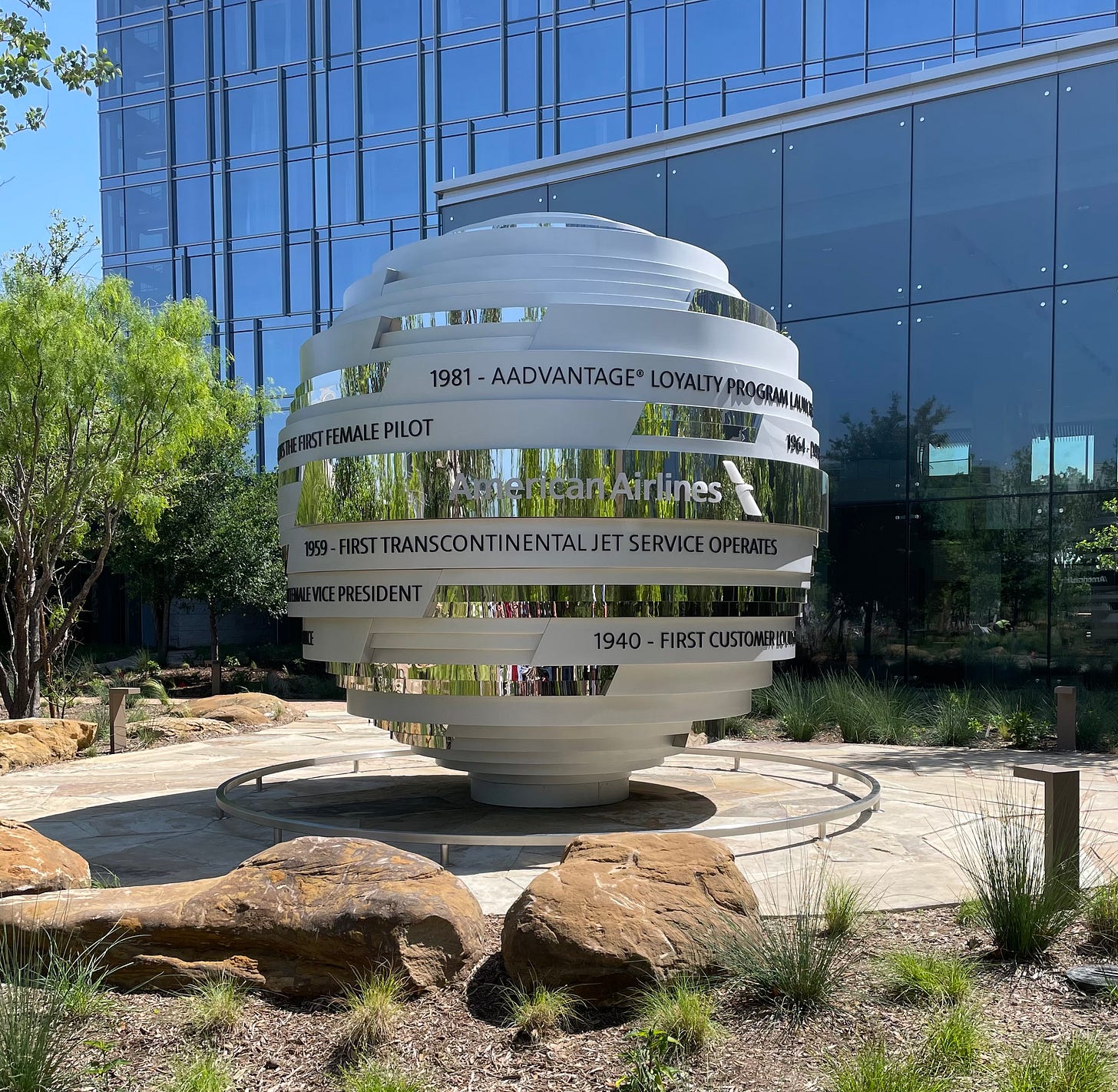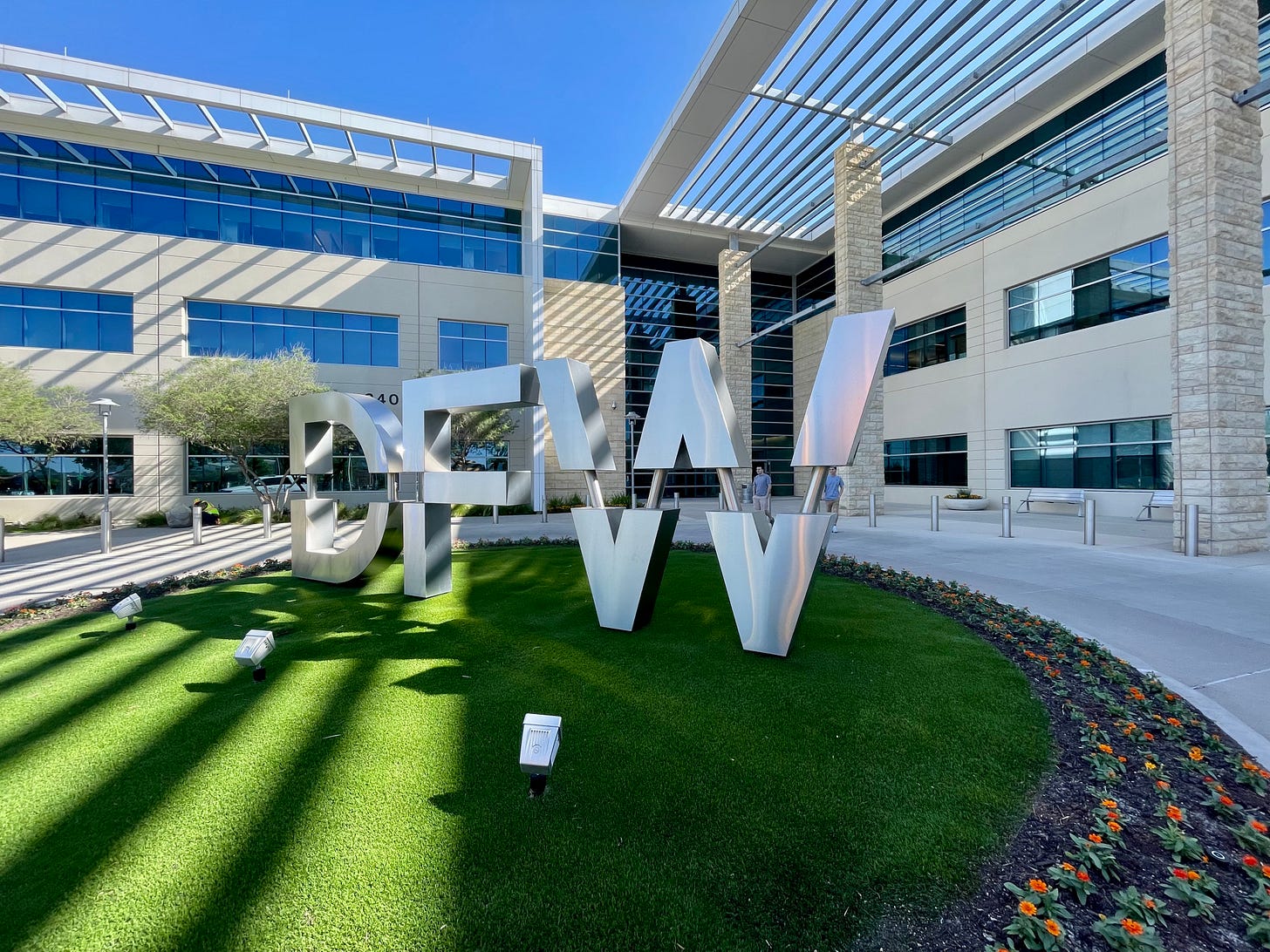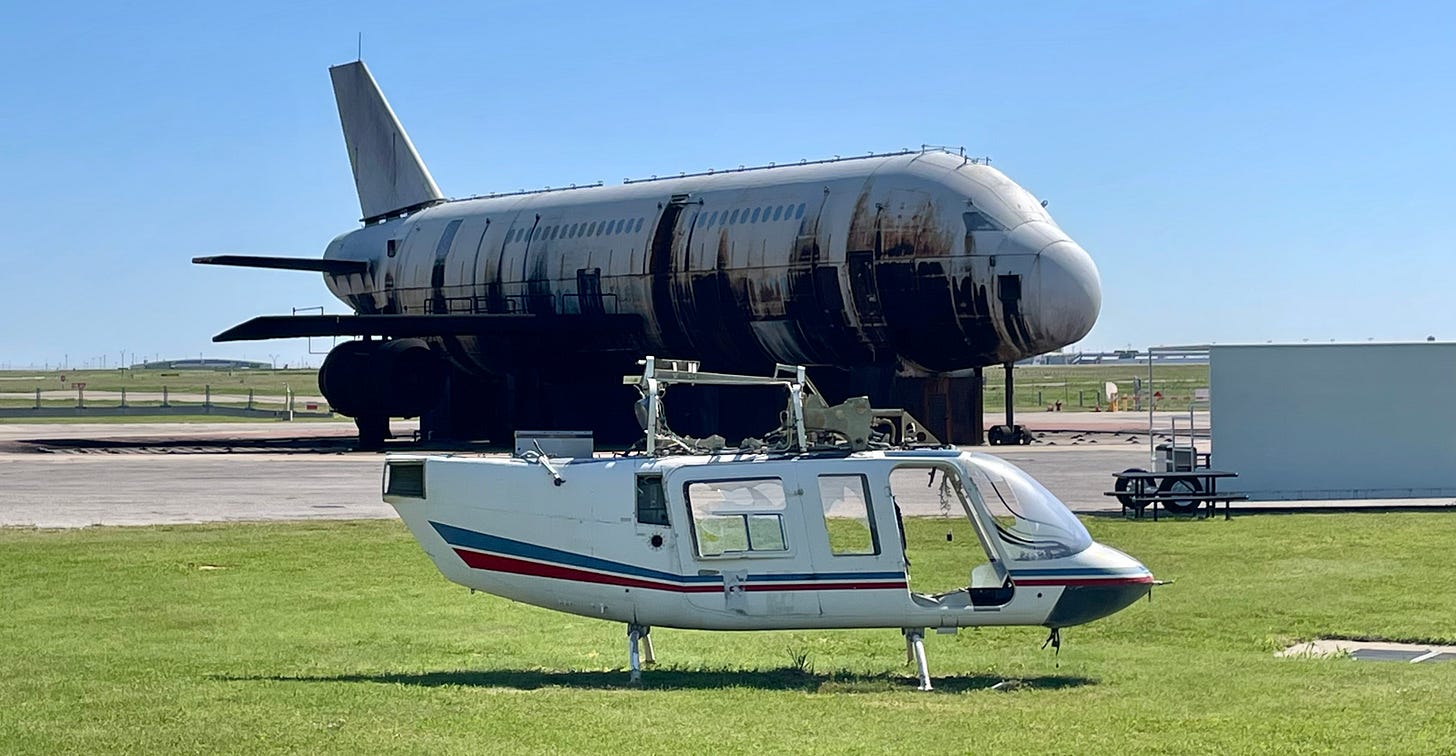American Airlines campus tour & behind the scenes at DFW
Great event organized by the Non-Rev Lounge podcast.
I had a fun weekend in and around the Dallas Forth Worth Airport. The Non-Rev Lounge Podcast hosted a meet-up for listeners, and the centerpiece was a tour of the new American Airlines corporate headquarters campus on the south side of the airport. I flew in from Santa Barbara for the event and my 19-year-old son joined me from Miami. About 90 other people also made their way there (many with amazing knowledge of aviation, past and present). Some of us also got to go on a behind-the-scenes tour of the DFW airport itself.
Non-Rev Lounge podcast
Non-Rev Lounge is a weekly podcast by three airline employees: a gate agent, flight attendant, and ramper. Its core focus is non-rev travel by airline employees and their families, but it’s also a great resource for other frequent flyers with its takes on air travel from airline employee perspectives. I try to listen to it every week, usually while running. My thanks to the podcast hosts — Monique, Lara, and Tyler — for arranging this event and also to those who helped them (especially Claudi, Kelsey, and Kyle). And further thanks to the hosts at American Airlines and DFW for their great hospitality.
American Airlines’ stunning new campus
The American Airlines campus is very impressive. It’s not like any other U.S. airline headquarters. It’s closer to what you’d expect from a tech company like Apple or Google. It consists of eight large glass buildings named Skyviews 1 though 8 arranged around greenery — not excessively manicured — and connected with walkways (and bikes for those inclined to peddle).
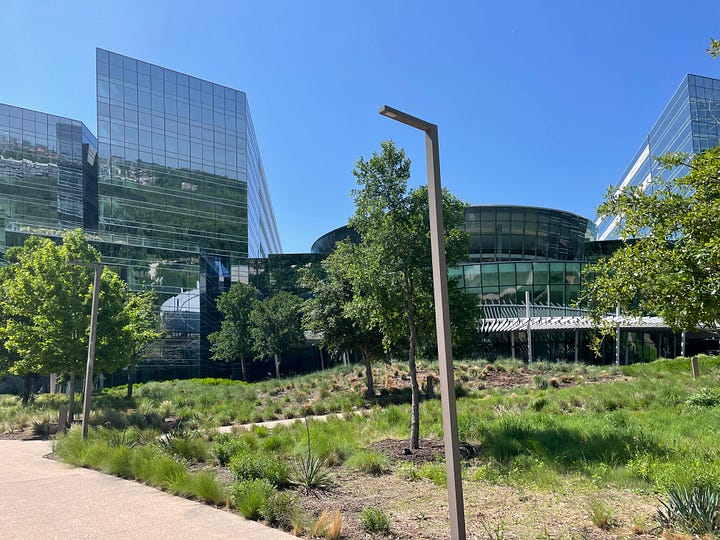

It’s subtle in a way, with a marked absence of loud corporate branding on the outside. You could pass close by and not realize what it is. Yet it is quite massive and architecturally stunning, providing a workplace and training environment to over 10,000 employees.
We got to tour inside and outside in small groups. Inside are numerous aviation-inspired details and sculptures, some quite whimsical (such as a sculpture built of seat-back safety cards and another of a giant seat belt).
The layout is designed to encourage people to gather in teams. There are spaces all over the place for that — some behind closed doors, others in the open. There are also numerous places — including outdoors — for employees to get food, recreate, and relax. As an example of how the buildings are designed to get people out of their own spaces, trash isn’t picked up from individual workstations. Rather, employees take it to central pickup points. The overall theme involves creating an environment for people to collaborate, not isolate.

The emphasis on workplace integration starts immediately with new hires. Most of the airline’s training now takes place on the campus. Functions that traditionally would took place in dispersed locations are centralized to help new and existing employees integrate with the company. So the campus houses American’s flight simulators for pilot training, as well as aircraft and check-in/gate mock-ups for flight attendant and ground staff training.
And the latest addition to bring it all together is a 600-room company hotel that is part of the campus and used exclusively by employees coming in for training or visiting on business. Our group only got to see the public areas, not the rooms. But from what I saw, the hotel is about as far removed from a Hampton Inn — or similar places where employees might normally be put up for this type of thing — as you could imagine. We were asked not to post photographs of the hotel just yet, as it is still embargoed pending a launch event coming soon, but the place is in some ways the crown jewel of the entire campus. We were treated to lunch in a spacious restaurant arranged like a food court where employees and visitors can pick up freshly cooked food from a variety of stations. The place was buzzing with new hires on a Saturday. Aviation training does not stop at weekends (or, in the case of simulator training for pilots, at night). Although we didn’t get to sample it, the hotel includes a bar.
The campus opened in 2019 not long before the pandemic struck. While many people in corporate America found themselves preferring to continue to work at home as the pandemic eased, I could well see wanting to get back to this type of in-person workplace.
The C.R. Smith Museum
We also visited American’s museum, located right next to the campus. Unlike the campus itself, this is open to the public. It is named after C.R. Smith, a legend in the company’s history. Smith came to the helm in 1934 after helping bring together many smaller mail-carrying operations — including “American Airways” — to create the new American Airlines. And he then collaborated with Donald Douglas to create the DC-3, an aircraft that helped transform the U.S. aviation industry into one more focused on carrying passengers than mail.
Today, the museum houses one of the original DC-3’s. Unlike in many museum aircraft, visitors can sit in the seats. Talking of seats, there’s also a cinema in the museum where visitors sit in first class seats removed from old aircraft, seatbelts still in place.
AA reflections
American Airlines has a string of “firsts” to its name. It was the first airline to fly transcontinental nonstops when it pioneered the DC-7 in the early 1950s. By the end of that decade, it had become the first to operate jets on those routes with the Boeing 707. In 1964, it was the first U.S. airline to hire an African American pilot. In 1973, it was the first to hire a woman pilot. And there are others, all captured on a sculpture outside the campus hotel.
I have come to love American Airlines. While these days my travel is generally as a non-rev passenger, I have approaching three million miles in its AAdvantage loyalty program as a revenue passenger — mostly flying on AA wide bodies — which gives me Platinum status for life (not that that counts for anything when non-revving). Candidly, there were times in the past when I chose American more for the overall benefits of its loyalty program than for the inflight passenger experience. Until the early 1990s, Pan Am and TWA owned all of the main international routes flown by US carriers. And when airlines like American — whose roots were primarily in domestic markets — took over from those failing carriers, it took a while to match the standards of global airlines.
But in the past 10 years or so, I have felt American has compared favorably with its European competitors on transatlantic routes. For example, American was well ahead of others — including British Airways and Lufthansa — in guaranteeing direct aisle access to every Business Class passenger. There was a time when I preferred to fly on AA codeshares operated by BA rather than on AA own metal. These days, while I still maintain some residual fondness for BA, the opposite is the case — whether at the front or back of the plane.
If I could change one thing about American, it would be to expand the scope of its current long-haul route network. Although American is the largest airline in the world on most metrics, and offers connections to just about anywhere via its One World partners and code shares, its “own metal” global reach is still behind, say, United. For example, American is the only one of the big three U.S. carriers not to fly to anywhere in Africa (a planned route to Casablanca became a victim of the pandemic). It probably doesn’t help that during the pandemic, American was more aggressive than some in retiring older aircraft — its entire 767 fleet, in particular.
And AA sometimes does not show the staying power of others on new international routes. I posted not long ago about the sad demise of its short-lived route from Miami to Paramaribo in Suriname. It is also beginning to look as though the planned Seattle-Bangalore route — announced as part of its West Coast alliance with Alaska — might never see the light of day. I hope I’m wrong. That said, there has been some international route expansion lately, notably JFK to Doha.
Behind the scenes at DFW
The day after the AA campus tour, a group of about 20 of us had the opportunity to go behind the scenes at the DFW airport, where American is by far the dominant carrier. The DFW airport headquarters where we started out is not far from the AA campus. We were driven from there to the DFW Fire Training Research Center, which is the main fire station and also a major training center for airport firefighters who come in from all around the world.
Firefighters there train on a variety of aircraft and structures. The Center has one of only two A380 trainers in the world, a full-height and width — although somewhat shortened — specimen of Airbus’ largest aircraft. Most days, this will be set on fire. But due to environmental issues, the firefighters train with water, rather than the foam they would use on a real fire.
Thankfully, the DFW firefighters have not had to deal with an actual plane crash since the 1980’s. Then there were two fatal accidents quite close to one another, in 1985 and 1988. Both involved Delta aircraft, one a wide-body Lockheed L-1011 landing at DFW and the other a B-727 departing. And both resulted in heightened aviation safety standards, the first in wind shear training and the second in sterile cockpit procedures.
But with as many as 100,000 people at DFW at any one time, there are plenty of other emergencies for firefighters to handle. They respond to several thousand incidents a year, including in communities near to the airport. Not long before our visit, they had put out a fire at the airport’s fuel farm.
After the tour of the fire operations, we were taken on an extended tour of other parts of the airport, crisscrossing runways and taxiways. It’s not often one gets to walk on a taxiway.
Other: DFW lounges and Spirit
DFW Admirals Club mini review: No trip report is complete without lounge coverage. American has four Admirals Clubs at DFW. The best, I think, is the one in the D terminal — which also happens to be the nicest terminal. That is the only one of the lounges with runway views. It also has showers. It may be worth a detour from another terminal if your time at DFW allows. You can connect between all five terminals at DFW without having to go through security again.
Spirit mini review: I flew into DFW on American. Flying out, I returned via Las Vegas leaving DFW on Spirit. It was my first-ever flight on Spirit. I liked the airline. “Low frills” doesn’t bother me if the experience is clean — in every sense of the word — and efficient, which mine was. But the Spirit experience may not last for long. I suspect that if the merger with Jet Blue happens — which is still far from certain — the resulting airline will be more JB than Spirit both in branding and frills. ✈️
Related post: Final call for American Airlines to Paramaribo
Coming soon on this blog: Istanbul Half Marathon review and trip report (the race is on April 30). Plus, soon after, a post on how to run your first half marathon within months, even if you’ve never run before. Then a review of the Hoka Sydney Half Marathon and associated trip report.

